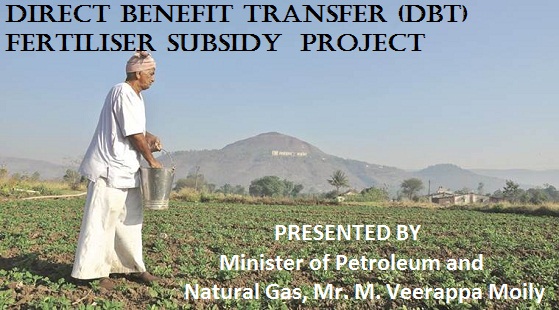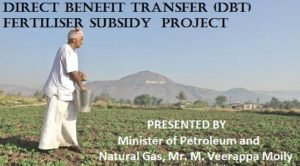Direct Benefit Transfer (DBT) Fertiliser Subsidy scheme
Direct Benefit Transfer Fertiliser Subsidy is a scheme that was launched back in 2013. The scheme is about giving subsidies to the farmers for fertilisers. After 4 years the scheme will be finally implemented in 2017 from the month of September. Under this scheme the payment for fertilisers will be made through point of sale machines.
| Scheme name | Direct Benefit Transfer Fertiliser Subsidy scheme |
| Launch date | 1st of June 2013 |
| Launched by | Minister of Petroleum and Natural Gas, Mr. M. Veerappa Moily |
| Implementation date | 1st of September 2017 |
| Beneficiary | All the farmers who have bank account link with aadhar card |
Important Point about the Scheme
- The POS machines have already sent to many fertiliser companies and also to the primary agricultural cooperative credit societies. These POS will be able to record the farmers’ information at the time of transactions.
- The scheme has objective of preventing the outgoing subsidy and also to reduce the inventories across the nation. It is also a step towards digitization as the payment will be made only through plastic money.
- The scheme will be started in 16 districts from selective state at this moment. This will be a trial phase. According to report many companies have received the POS until now but there are still few left. Before start it officially, the government wants to run a trial.
- As per the reports the subsidised amount will be credited after few days of transaction directly to the company’s account. Also it has been said that the farmers will get subsidy amount however no official transfer process has been announced yet.
- Many a cases have come up in recent times about the smuggling of subsidised fertilisers in neighbourhood countries. Farmers buy these fertilisers at lower price and sell them at market price to other countries or places. This scheme will check the volume of product each farmer is buying to control smuggling and such activities.
- The budget for the scheme is set at Rs. 70, 000 Cr for the first phase. The entire budget will be used to provide subsidy on fertilisers only. With the proper implementation of the scheme, nearly 140 Million farmers will get benefitted.
How it works
- The farmers have to buy the subsidised fertilisers through POS. These POS will record the information about the farmers and also it will record the transactions made by the farmers as well. This recording activity will take place every time the farmer buys fertilisers.
- As the information of the farmers will be captured, it will help the authority to track the exact volume of fertiliser is sold. Depending on that record the government will release the subsidies to the company.
- This POS system is launched to get rid of any sort of corruption, malpractice or irregularity in the system of private fertilisers’ company.
Subsidy items
There are a number of products on which subsidy will be given under the scheme. They are as follows Ammonium Sulphate, Di-Ammonium Sulphate, Muriate of Potash, Super Phosphate and Urea. Also some other complex fertilisers will be available at subsidised rates under this scheme.
Who will get the benefit?
Beneficiaries who have Aadhaar Cards and also they have bank accounts linked with their aadhaar number will get the benefit of the scheme. As it is mentioned that the subsidised amount will be sent through Aadhaar Payment Bridge, the beneficiary will have to have an aadhaar linked bank account. As mentioned companies will get the subsidised amount after 2 or 3 business days of transaction, the process is expected to be faster.
Also using POS will not allow the companies to offer high price or wrong price from the farmers. As well as the companies will not be able to perform any malpractice regarding the same.
The scheme has launched in 2013 but start implementing in this year only. During the month of June and July it was said to be launched. But lack of POS machines has restricted the authorities to start the scheme on time. As of now The Department of Ramnathpuram and Shivaganga have received 161 and 166 POS respectively. These POS have distributed among the private suppliers and Primary Agriculture Cooperative Credit Societies.

